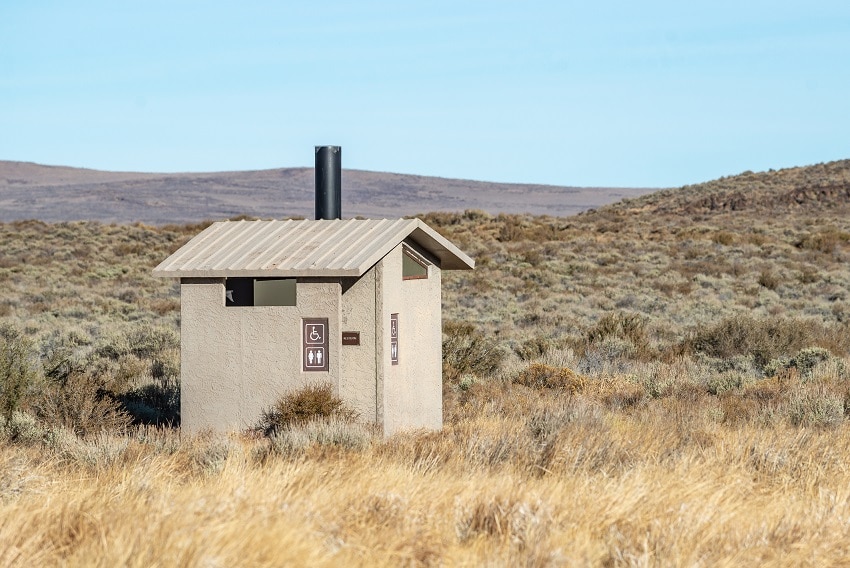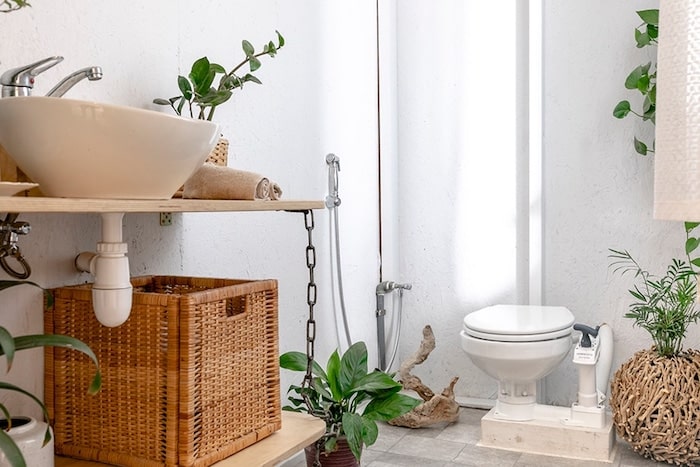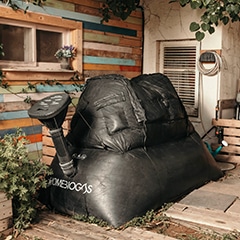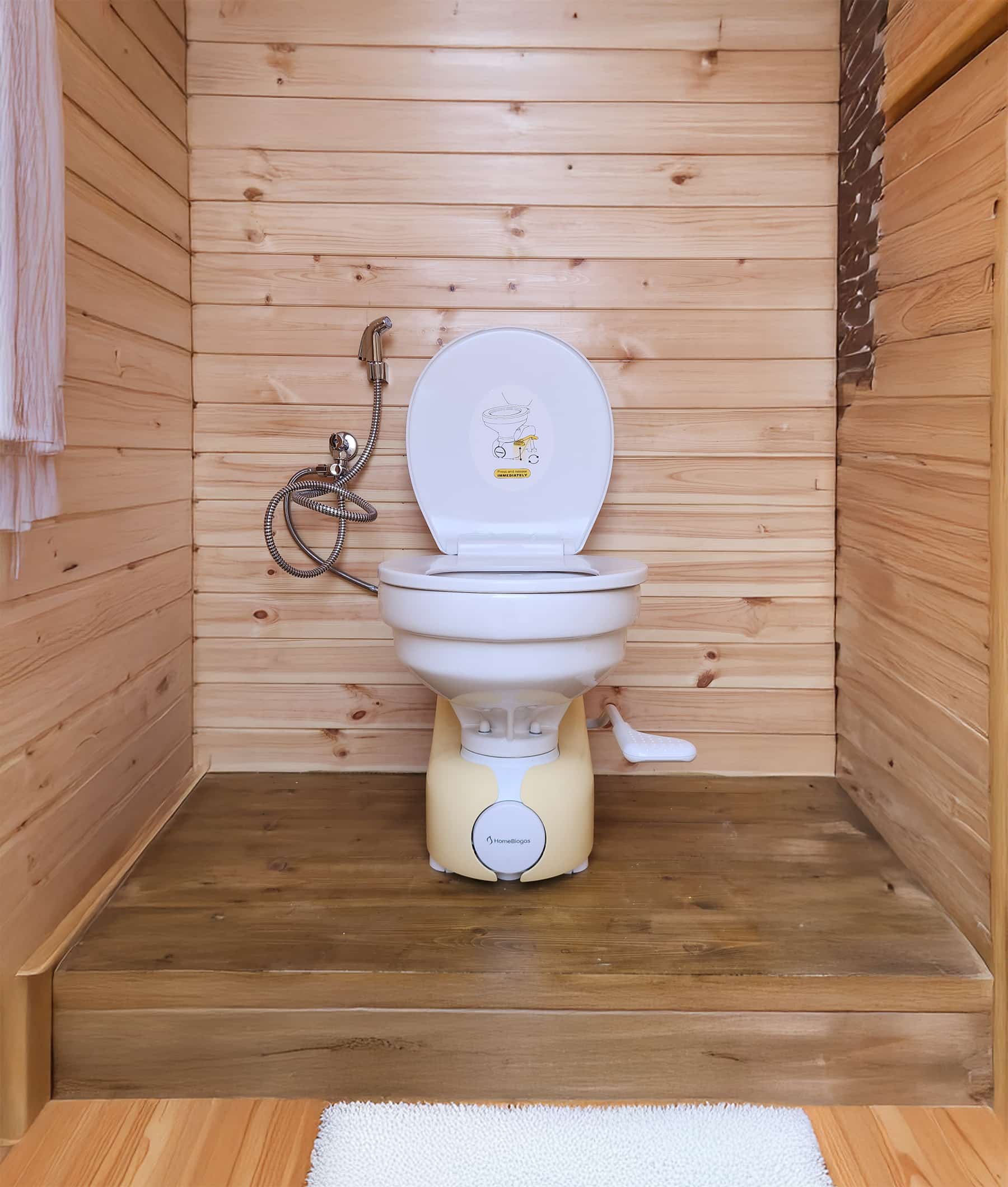
What is a pit toilet?
The term pit toilet refers to sanitary equipment in the form of a waste-containing hole in the ground used to collect waste material and restrict human and environmental exposure. The construction includes a concrete slab or floor with a small hole sometimes connected to a toilet seat, a lid to cover the spot, and a shelter.
The hole in the ground can be unlined or treated with a strengthening agent, vented, or unvented. Pit toilets are suitable for both family and communal usage. When the pit toilet serves large numbers of users, you can build a series of separate pits to store waste on a larger surface area.
The fecal sludge trapped in the pit degrades over time, but a pit toilet isn’t complex enough to control pathogen concentration. Pathogen reduction can sometimes occur, but that process is hard to manage without consistent temperature and humidity levels inside the pit.
Estimations say that around 1.77 billion people worldwide use pit latrines as their primary human waste management solution.
Do pit toilets have a “life expectancy”?
The system can function for five to ten and even 30 years, depending on its design, dimensions, and frequency of use.
When the waste finally fills the pit, you can remove the sludge or cover the hole with soil. If you opt for the second option, bacteria and earthworms will continue the decomposition process until the organic matter fully decomposes.
The difference between regular and pit toilets
A pit toilet is most suitable for people who are comfortable using an outdoor toilet. Another significant difference between regular and pit toilets is the water usage. Pit toilets usually use little or no water to function, helping reduce water consumption and bills. Another option in toilets to consider is the HomeBiogas Bio-toilet, which is designed to look and feel like a regular toilet and unlike a pit toilet, it’s odorless and mess free.
Other names for pit toilets
Pit toilets are also known as pit latrines, pit privies, or household latrines. The shelter that hosts the pit is often called an outhouse. Pit toilets shouldn’t be confused with vault toilets, which use a sealed container (or vault) buried in the ground to store human waste, so it doesn’t make direct contact with the soil.

Where can you use a pit toilet?
Pit toilets are usually used on off-grid properties and sometimes at campsites or in national parks. These constructions aren’t recommended in urban areas, as there’s not enough space for safe waste management with this method.
As a rule of thumb, pit toilets should be used in areas where the soil has a slow rate of percolation. This way, you can prevent waste liquids from entering deep underground before bacteria breaks down pathogens.
In many countries, the popularity of pit toilets is smaller than ever before, as environmental regulations become more rigid and alternatives with improved sanitary benefits become available.
Pit toilets design considerations
Building a pit toilet is relatively simple, but a series of safety measures should be taken to prolong the construction’s life expectancy and ensure no one gets hurt.
- When you excavate the pit, use some of the resulting extra soil to build a small berm around the hole’s edge. This extra spet helps keep rain and surface water out of the pit to prevent extreme moisture inside the hole and groundwater contamination.
- If the soil has a high percolation rate, use absorbent organic materials to line the base and the walls of the pit. This will give bacteria enough time to break down the waste before the liquid ends in the solid, preventing contamination.
- Ensure that the hole in the floor has a diameter under 25 centimeters/10 inches. This makes it difficult for children to fall into the pit.
- Protect the construction with a shelter or outhouse. This way, you increase user comfort and protect the pit from increased water intake during heavy rain.
- Whether you use a toilet seat or any alternatives, provide a wooden or plastic lid to cover the hole when the toilet is not in use. This prevents foul odors inside the shelter and keeps flies and other insects away.
- Ensure that the pit doesn’t receive too much light, so it doesn’t attract flies or other insects.
Pit toilet types
Dry toilets and pour-flush pit latrines
- Dry pit toilets don’t use water, so there’s no need to be connected to a clean water source.
- Pour-flush pit latrines are an improved version of the traditional dry pit toilet, being more similar to a septic tank. Besides the hole in the floor, the system requires a ceramic or plastic element that permits the existence of a water seal, preventing odors. You can use recycled or collected water to minimize its impact on your water bill.
Unventilated and ventilated pit toilets
- Unventilated pit toilets are simple constructions that don’t provide the pit with any additional airflow.
- Ventilated pit toilets include a ventilation pipe usually higher than the structure that permits air circulation, reducing odors and insects.
Pit toilet maintenance
Pit toilets are known to require minimum maintenance throughout their life. The human waste gets stored in the pit, and no human intervention is needed. To avoid overflow, you still need to monitor the sludge level inside the hole.
It requires emptying when the pit is almost full — about 3 feet/1 meter from the edge. The most common ways to remove waste from a pit toilet are with manually powered pumps or motorized pumps, which usually move the sludge in a vacuum truck, further transporting it to a designated location, such as a sewage treatment facility or a composting facility.
Alternatively, you can cover the pit with soil, excavate another hole, and move the upper structure.
How to safely use a pit toilet
When using a pit toilet, start by using the environment. Make sure you have enough toilet paper and hand sanitizer. Ensure the pit doesn’t include too much water that can splash back at you, and always pay attention to how you sit so you keep the space clean for yourself and the other users.
Secure all your belongings before using a pit toilet — if something falls inside the pit, it will be impossible for you to recover it.
Never use the pit toilet to dispose of any organic or inorganic garbage, as this will only fill the pit faster and prevent waste from decomposing correctly. Last but not least, remember to cover the hole after usage to reduce odors inside the outhouse.

Pros & cons of using pit toilets
Advantages:
- Building a pit toilet implies low upfront costs.
- This system requires minimal maintenance.
- Water consumption is minimum or unexistent.
Disadvantages:
- It can be challenging to manage odors or insects.
- The construction must be placed outdoors.
- The decomposition process is slow and doesn’t impact pathogen concentration.

HomeBiogas Bio-toilet
Designed for the next generation of green innovation.
What the future holds for pit toilet waste management
The small cost remains the primary reason why so many people continue to rely on pit toilet waste management. Traditional pit toilets are cheaper and easier to build than their more advanced versions, as they don’t include any mechanical parts. Moreover, they require minimum maintenance and don’t need repairs, making them practical in most situations where other waste management solutions aren’t accessible.
More than 50% of the global population doesn’t have access to managed sanitation services, so dry pit toilets continue to be a viable alternative for safe waste management. However, as improved sanitation facilities, such as flush latrines, septic tanks, ventilated latrines, or composting toilets become more accessible, fewer communities might rely on this system in the long run.
Embrace Sustainability with HomeBiogas Bio-Toilet: A Revolutionary Alternative to Pit Toilets!
Say goodbye to conventional pit toilets and embrace the eco-friendly future with HomeBiogas Bio-Toilet! Our cutting-edge system offers an innovative and sustainable solution to human waste management. No more dealing with unpleasant odors or handling waste manually. The HomeBiogas Bio-Toilet utilizes advanced anaerobic digestion technology to transform human waste into clean cooking gas and treated effluent. It’s a game-changer for off-grid living, sustainable communities, and environmentally conscious households. Step into a world of green living and self-sustainability with the HomeBiogas Bio-Toilet today!

Conclusion
Pit toilets are one of the oldest waste management solutions known, and they still serve a significant segment of the population worldwide. However, this system leaves considerable room for improvement. While advanced versions of a pit toilet can meet a modern household’s expectations, the standard version lacks a series of characteristics that make an effective sanitation service.
It’s an ecological toilet, but it doesn’t control pathogen concentration and comes with environmental and healthy risks that can easily be avoided with other eco-friendly systems.






